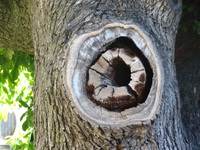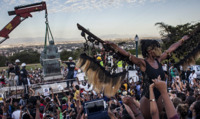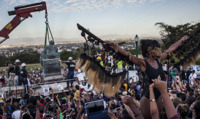Items
Site
The Medicine Chest
keywords is exactly
Cecil John Rhodes
-

Kimberley, South Africa: miners and washing gear at the Bultfontein diamond mine
Woodburytype -

Griqualand West, South Africa: Kimberley diamond mine.
Woodburytype -

Kimberley Mine
A detail from the wallpaper used outside the Cape Town Diamond Museum in the V&A Waterfront. -

Kimberley Mine 1886
Plate from Williams, G. 1902. 'The Diamond Mines of South Africa: Some Account of their Rise and Development'. New York, London: Macmillan. -

Kimberlite
A display outside the Cape Town Diamond Museum in the V&A Waterfront -

Kimberlite
Kimberlite specimens, UCT Mantle Room -

Kimberlite
Kimberlite specimen, UCT Mantle Room -

Cecil John Rhodes statue
The man who consolidated thousands of small diggings in Kimberley to found De Beers Consolidated Mines was Cecil Rhodes, who then used the profits to extend into gold mining in and around Johannesburg. -

The Diamond Mines of South Africa: Some Account of their Rise and Development.
“In the mines operated by the De Beers Company alone, more than eleven thousand African natives are employed below and above ground, coming from the Transvaal, Basutoland, and Bechuanaland, from districts far north of the Limpopo and the Zambesi, and from the Cape Colony on the east and the south to meet the swarms flocking from Delagoa Bay and countries along the coast of the Indian Ocean, while a few cross the continent from Damaraland and Namaqualand, and the coast washed by the Atlantic. The larger number are roughly classed as Basutos, Shanganes, M'umbanes, and Zulus, but there are many Batlapins from Bechuanaland, Amafengu, and a sprinkling of nearly every other tribe in South Africa” (Williams 1902: 412-413). -

The Diamond Mines of South Africa: Some Account of their Rise and Development.
“The initial impetus for establishing a collection of mantle materials for research purposes in South Africa was provided by Gardner Williams and his son Alpheus Williams in the late 19th and early 20th century. These two American mining engineers shared a great interest in the mining methods and geology of the South African kimberlite-hosted diamond mines they were supervising. Each wrote books on the subject and the two men assembled a collection of scientifically interesting rock samples and minerals from the mines. Subsequent to the death of Alpheus Williams, the Williams family donated this collection to the Geology Department at UCT for teaching and research purposes” (Department of Geological Sciences 2021). -

Lacuna (Part one)
"It is interesting to note that the botanical origins of most of these medicines were from outside of Africa, especially if one considers the long history of the Cape as a point on the trade routes where ill sailors regularly disembarked and drew on the knowledge of the Khoekhoe traditional healers for treatment and herbal cures (Laidler & Gelfand 1971: 44). The Cape flora offered a plenitude of medicinal resources and these healers (who were skilled in botany, surgery and medicine) used them in a variety of healing practices . The exclusion of local botanical remedies in the BWC No. 254 medicine chest can be attributed to many factors" (Liebenberg 2021: 67). -

Lacuna (Part two)
An ill English Oak on Hiddingh Campus, Michaelis School of Fine Art, University of Cape Town. English oaks were first brought into the country by the early settlers and were one of the first exotic tree species to be planted in South Africa, shortly after Van Riebeek’s arrival in 1652. He explained that in South Africa, these trees do not grow as old as they would have in Europe. The high temperatures cause these trees to grow faster than their species back home, and because of this, their centers start rotting over an extended period of time. The center part of the wood – the heart – is affected by this occurrence and hollowed out over time. -

Smallpox
"In Kimberley in 1883-4, several leading doctors with links to the diamond-mining industry publicly denied the presence of smallpox among migrant workers, instead diagnosing them as suffering from a rare skin disease. They appear to have done so lest admitting that the dreaded smallpox was raging, which would have affected the supply of labour and materiel and thereby interrupting mining operations. Led by Cecil Rhodes’s friend, Dr Leander Starr Jameson, measures to curb the epidemic were sporadic or, in the mining compounds, non-existent, and cases topped 2000, with mortality at 3.5 per cent of the population. Only when the colonial government eventually called in external doctors to diagnose the disease, was the cover-up terminated and vaccination, fumigation and isolation vigorously pursued. The conspiracy of denial, by retarding action and sowing doubt about the need to be vaccinated, had been responsible for no small percentage of the 700 deaths in the town" (Phillips 2012: 32-33). -

Kimberlite
"UCT was founded in 1829 as the South African College, a high school for boys. The College had a small tertiary-education facility that grew substantially after 1880, when the discovery of gold and diamonds in the north – and the resulting demand for skills in mining – gave it the financial boost it needed to grow. The College developed into a fully fledged university during the period 1880 to 1900, thanks to increased funding from private sources and the government. During these years, the College built its first dedicated science laboratories, and started the departments of mineralogy and geology to meet the need for skilled personnel in the country's emerging diamond and gold-mining industries (Ritchie 1918: 495-496)". -

Chapunga - The day Rhodes fell
The character Msezane is portraying depicts the statue of the Zimbabwe bird that was wrongfully appropriated from Great Zimbabwe by the British colonialist Cecil Rhodes. It currently sits in his Groote Schuur estate. -

What UCT is not telling its first years
On the 19th of January 2015, an article appeared in the Cape Argus titled 'What UCT is not telling its first years' written by Dr Siona O’Connell, a staff member of the Centre for Curating the Archive, and lecturer at the university. In it she wrote about the absence of transformation in the university, evident in its lack of black academic staff, describing the campus as "mired in unarticulated tensions and divisions, many of them pivoting on race” and “guarded by the Rhodes Memorial – a significant imperialist edifice” that continues to shadow it “in many overt and covert ways” "(O’Connell 2015). In the article she pinpoints that even though, as first years, they will most certainly be greeted by the statue of Cecil John Rhodes overlooking the rugby field during their tour of the campus, their chances of being taught by a black professor during the full span of their degree, will be incredibly slim…


